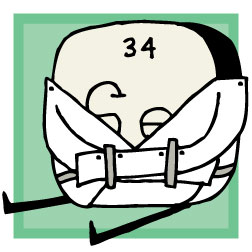Blogging the Periodic Table

If, like a package of food, you had a list of ingredients stamped in an out-of-the-way spot like the bottom of your foot—with the elements that make up most of your weight coming first—it would read something like this: oxygen (65 percent), carbon (18 percent), hydrogen (10 percent), nitrogen (3 percent), calcium (1.5 percent), phosphorus (1 percent), potassium (0.4 percent), sulfur (0.3 percent), sodium (0.2 percent), chlorine (0.2 percent), magnesium (0.1 percent), iron (0.005 percent), zinc (trace), and iodine (trace).
Oxygen and hydrogen make up water, carbon makes up almost everything else, and most of the other elements appear in DNA, proteins, or salt. About the only surprise here is an element missing from the list—silicon, which makes up one-quarter of the entire earth's crust but (aside from stray atoms in our hair) one that our bodies ignore.
But the list gets more intriguing when you catalog the really scarce elements in our body, those below iodine. I'm not talking about elements we absorb accidentally because of industrial pollution (like lead and mercury). I'm talking about ones our cells require daily or they start to malfunction. On that list you'll find chromium, cobalt, copper, manganese, molybdenum, nickel, and selenium, among others. These are all metals, substances we usually think of as the opposite of soft, squishy biology, and certainly not elements we hear about for keeping a balanced diet. But a diet that lacks any one of them will leave you sick and hobbled, if not dead.
Take selenium. A chronic lack of it can cause heart cells and cartilage to die, as well as disrupt the thyroid gland. The level of selenium in the blood of AIDS patients is very strongly linked to the likelihood of death—low selenium levels means the person is doomed. Doctors haven't sorted out yet whether low selenium levels contribute directly to AIDS deaths or merely correlate with them, but our bodies use selenium as an antioxidant, and a lack of antioxidants puts stress on cells. Given that immune cells in AIDS patients are already stressed, the lack of selenium may in fact do them in.
If low selenium levels cause medical problems, and if AIDS patients have low selenium levels, why not load them up with selenium supplements? Two reasons. First, no one knows what strips the selenium out of the cells of AIDS victims. So giving them more without fixing the underlying problem might be futile, like pouring water into a bucket with a hole. Second, however important as a micronutrient—you need at least 55 micrograms per day (usually from meat, eggs, or nuts)—selenium becomes toxic pretty quickly. Too much selenium can cause internal problems like intestinal and brain damage, and it can make your hair and fingernails fall out. Oddly, it will also make your breath reek like garlic—a trait selenium shares with a few other oddball elements on the periodic table.
Another hesitation might be that selenium has been strongly linked, at least in folklore, with madness. The legend springs from the fact that a variety of plants in the American West, commonly called locoweed, have a strange physiology and need lots of selenium to grow. These plants bloom beautifully in the spring, attracting the attention of range animals like cattle and sheep, which aren't too discriminating about what they eat anyway. But when they eat locoweed, they begin to bellow and stumble—symptoms known as the "blind staggers"—and develop sores, fevers, and anorexia. Horses that eat locoweed show the same symptoms of derangement, and so, presumably, would humans. (Some shall we say creative historians have pinned Custer's loss at the Battle of the Little Bighorn on his horses eating locoweed before the battle.) All this hasn't helped selenium's reputation.
An overdose of selenium can be fatal—just last year, 21 polo ponies slumped over dead before a match in Florida after receiving vitamin injections with too much selenium—but scientists have re-evaluated the evidence for it causing madness. They now think that other chemicals in locoweed (like swainsonine) actually cause the derangement. So in the end, Element 34 is just another micronutrient, a stray element that our bodies for some reason decided to put to use in our past. It's probably not a miracle cure for AIDS, but it doesn't cause insanity, either—it's neither a periodic table hero nor one of its villains.
Like Slate on Facebook. Follow us on Twitter.